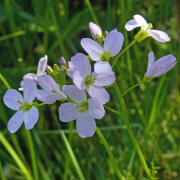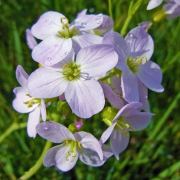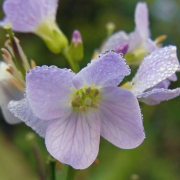Cuckoo flower Cardamine pratensis
Table of Contents
Sometimes referred to as ‘Lady’s smock’ the attractive white – pink flowers of this wildflower come into bloom around the same time as the cuckoo makes his call, hence the name ‘cuckoo flower’. It’s happiest growing in damp conditions, such as river banks, pond margins and damp grassland.

Plant family: Brassicaceae
Aliases: Lady’s smock, bread and milk, mayflower, spring cress
Flowering Period: April – June
Flower colour: White – pink
Preferred soil type: Moist, damp
Habitat: River and dyke banks, pond margins, damp meadows
Status: Common
General information
An early flowering, herbaceous, perennial wildflower found in damp places, such as pond and ditch banks, roadside verges, damp grassland in open or semi-shaded environments, through out the British Isles. This attractive plant is known by several names, but its most common name is derived from its flowers forming at the same time the cuckoo arrives in the UK, during the spring time.
This native plant grows to height of between 30 – 50 cm, whilst is spreads via rhizomes (horizontal underground runners) to small colonies of plants, with a spread of about a metre.
Identification

Flowers: Each flower has four white – pink petals with yellow centers, measuring up to 10mm across. The petals have deep dark pink – purple veins running through them.
Leaves: The lower leaves form as a basal rosette are pinnately compound (leaves form opposite each other on a central stalk, finishing with a single terminal leaf). These basal leaves grow up to 120 mm in length, with up to 15 leaflets, the end leaflet being the larges. The upper stem leaves are stalk-less, with narrow linear.
Value for wildlife

Cuckoo flower is a valuable source of food for many types of Bees, hover-flies and moths. It’s also visited by the Orange-tip & green-veined white butterflies that feed on the flowers and lay eggs on the leaves, which their larva will later feed on.
Uses of cuckoo flower
Cuckoo flower has medicinal properties, and in the past is ahs been used to treat menstrual disorders, skin conditions and asthma. It has also been used as a diuretic and an appetite stimulant.
In terms of being edible, it has a peppery or mustard taste to it and is actually a member of the mustard family. It has been used in salads as a cress substitute to spice things up a little. It’s also a rich source of vitamins ( It is especially rich in vitamin C).
Cuckoo flower images
Click to enlarge

This work is licensed under a Creative Commons Attribution 4.0 International License.
You are free to use, share and adapt any of the images on this page, under the condition we receive a followed backlink to our website https://diversegardens.co.uk as the image source.















